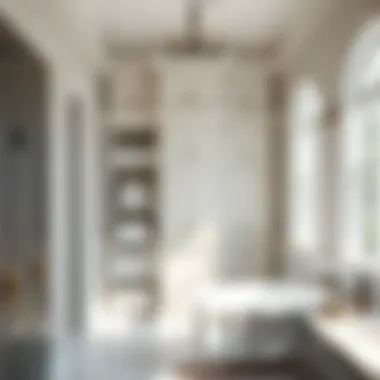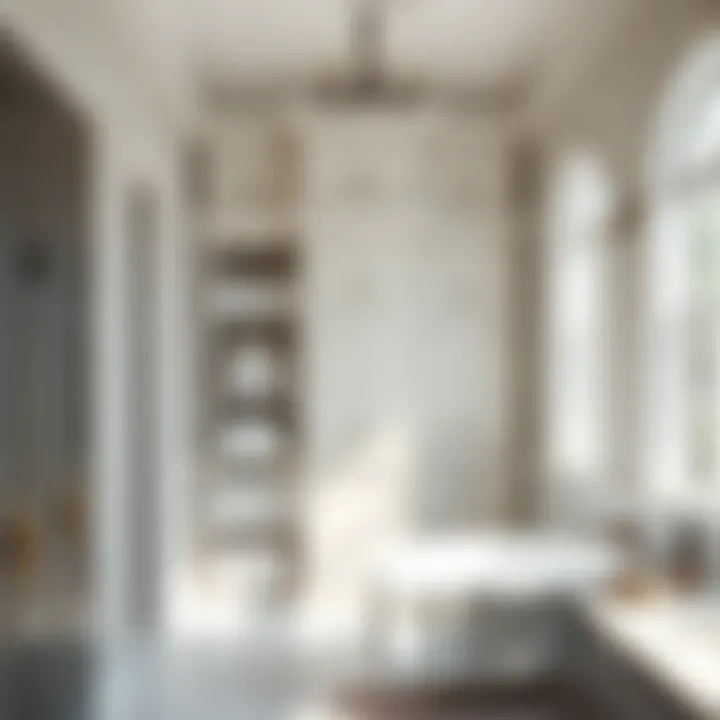Building a Functional Linen Closet in Your Bathroom


Intro
Creating a linen closet in your bathroom is not just about storage; it’s about optimizing the space to enhance functionality and aesthetics. A well-organized linen closet serves as the nucleus of your bathroom operations, providing quick access to towels, toiletries, and other essentials. While it may seem like a straightforward task, the nuances involved in designing and constructing such a space can be quite intricate.
When thinking about the design, one must consider factors such as layout, materials, and styles that harmonize with the overall look and feel of the bathroom. This guide dives into the essential steps necessary for planning, selecting materials, and executing the build. Homeowners and design enthusiasts alike will find this detailed guide useful for transforming their bathrooms into efficient and visually appealing sanctuaries.
Design Inspirations
Trending Styles
Designing a linen closet involves more than just the practical aspects—and that’s where style comes in. There are a few trending approaches that homeowners can consider:
- Modern Minimalism: This style emphasizes clean lines and simplicity. A linen closet reflecting this trend would feature sleek shelving and integrated storage solutions, devoid of unnecessary clutter.
- Rustic Charm: Utilizing reclaimed wood and vintage elements imparts warmth and charisma to the space. Here, aesthetics can be achieved while not sacrificing utility.
- Contemporary Elegance: This is where modern meets classic. Think bold patterns paired with soft colors—a curated blend that adds sophistication and elegance to everyday essentials.
Each style not only has its visual appeal but also informs functionality. For example, modern minimalist designs may prioritize easy access and clarity, while rustic charm could celebrate the uniqueness of individual items through open shelving.
Color Palettes
Choosing the right color palette for a linen closet can be pivotal in setting the mood of the bathroom. Colors can either enliven the space or provide a serene backdrop to your daily routine.
- Soft Neutrals: Shades like muted grays, off-whites, or taupes offer a calming effect perfect for creating a serene atmosphere. They pair well with various decor and are timeless.
- Bold Accents: Colors like deep teal, vibrant mustard, or even a glossy black can add character to the closet. Utilizing these in accessories, such as basket liners or tiny decor items, elevates the visual interest without overwhelming.
- Pastel Tones: Soft pinks, blues, and greens can provide a refreshing vibe. Ideal for small bathrooms, they create an illusion of space while keeping the atmosphere light and airy.
Regardless of the style or color palette chosen, ensuring that the linen closet complements the rest of your bathroom can significantly affect the overall feel of the space.
"A well-considered design approach allows the linen closet to be a harmonious part of the bathroom rather than a mere utility space."
Ultimately, the design should cater to your specific needs, turning the linen closet into more than just a storage solution.
Understanding the Need for a Linen Closet
Creating a functional and visually appealing bathroom often hinges on the processes of thoughtful planning and organization. A linen closet offers a dedicated space to store essential items like towels, bedding, and toiletries, and it serves multiple purposes that elevate the overall utility of your bathroom.
The Importance of Organization
When it comes to home management, organization is king. A well-designed linen closet transforms haphazard clutter into a neat and structured arrangement. This is vital not only for making daily life smoother but also for cultivating a sense of tranquility within the often-busy bathroom environment. Imagine being able to easily locate that fluffy towel or the matching set of bed linens without turning your house upside-down. An organized linen closet promotes efficiency, allowing you to quickly grab what you need without wasting time rummaging through drawers or cabinets.
"A place for everything and everything in its place" highlights the sturdy foundation of domestic organization.
Effective organization extends beyond mere aesthetics; it positively influences mental well-being. A tidy space is often perceived as welcoming and calming, which can enhance your daily experience as you go through your routines.
Maximizing Small Spaces
In many homes, bathrooms often embody tight quarters, making it crucial to maximize every available inch. A linen closet can be a game-changer, especially in small spaces. By carving out a specific area for linens, you can efficiently use vertical space through shelving, rather than relying on bulky furniture or storage ottomans that might cramp your style.
Opting for built-in solutions or slimline designs allows homeowners to tuck a linen closet into an otherwise wasted nook. This not only conserves space but also provides a designated area, improving overall accessibility. It’s like finding a hidden gem in an antique shop; you just have to look carefully and think creatively.
Enhancing Bathroom Aesthetics
Beyond functionality, a linen closet can significantly elevate the look of a bathroom. An aesthetically pleasing closet complements the decor of the room, creating a cohesive design narrative. Whether you lean towards modern, rustic, or classical styles, you can design your linen closet to reflect your personal taste.
Consider incorporating elegant materials or colors that resonate with the overall theme of your bathroom. The ability to display neatly folded linens or curated storage bins adds a touch of sophistication. For instance, using wood grains in a minimalist bathroom can create warmth, whereas metal accents can lend a modern edge.
In short, a well-thought-out linen closet does much more than just provide storage; it becomes a part of your bathroom's charm and narrative.
Design Considerations
When crafting a linen closet in your bathroom, there are several design considerations to keep in mind. This phase is vital, not only for functionality but also for ensuring the closet complements the overall bathroom aesthetic. Planning effectively at this stage can save you time and resources, resulting in a well-integrated space that remains practical.
Assessing Available Space
First and foremost, it’s crucial to assess the available space in your bathroom. Every square inch counts, especially in smaller bathrooms.
Begin by measuring the area where you intend to place the linen closet. Note down features such as doors, windows, and plumbing that might impact your design. Consider the height, width, and depth of your selected location. A linen closet doesn’t have to be expansive; sometimes, utilizing vertical space can yield maximum storage without cramping your style.


"Always measure twice, cut once." This Adage rings truer than ever in home improvement, where miscalculations often lead to costly errors.
Once you've got your dimensions jotted down, visualize how you’ll use this space. If you have room for shelves, think about how many towels, linens, or baskets you'll need to store. Essentially, organizing your items mentally helps design a space that fits your needs down to a tee.
Choosing the Right Location
The next step is deciding on the optimal location for your linen closet. The spot should strike a balance between accessibility and aesthetics. Ideally, the linen closet should be easily reachable but not obstructing other bathroom functionalities.
Look for gaps in your current layout. For instance, the area above the toilet could be a smart choice for a compact linen closet. Consider whether this area can accommodate a closet without being an eyesore. Also, ensure that it’s close enough to the bathing or changing areas, making it convenient to grab fresh towels or linens.
When selecting the location, also keep in mind the room’s flow. You don’t want to create a bottleneck in your daily routine. Instead, look for a corner or a wall that often gets overlooked yet could serve as a practical storage area.
Integrating with Existing Decor
Once you’ve decided on the location, the next challenge is to integrate the linen closet with the existing decor of your bathroom.
The goal is to choose materials, colors, and styles that align with what’s already present. If your bathroom has a modern flair, sleek cabinet doors and minimalist handle styles will resonate well. Conversely, a rustic-themed bathroom could benefit from reclaimed wood or distressed finishes that add charm.
Consider the color palette as well. Whether you opt for understated shades or bold, eye-catching colors, your linen closet should either complement your space or become a tasteful focal point. Neutral hues may blend in nicely, while a pop of color might spark joy and give your bathroom character.
Incorporating matching or complementary hardware, like doorknobs and hinges, further entwines the linen closet with the overall design theme, allowing for a seamless merge without compromising on functionality.
All in all, these design considerations work hand in hand to create a linen closet that’s not only useful but also adds value and appeal to your bathroom. Taking the time to assess space, choose a location wisely, and carefully integrate with existing decor ensures that your linen closet will serve you well for many years to come.
Planning Your Linen Closet
Planning your linen closet is a crucial step in enhancing the functionality of your bathroom. A well-thought-out plan not only makes it easier to find what you need but also optimizes the space you have, making a smaller bathroom feel less cluttered. It’s like piecing together a puzzle; if you get the layout right, everything comes together seamlessly.
Creating a Blueprint
Creating a blueprint is about laying the groundwork for what your linen closet will be. This means thinking about how you want it to look and function before getting your hands dirty.
Selecting Dimensions
Selecting dimensions for your closet is a major part of the blueprint process. The right size can significantly impact both convenience and aesthetics. Consider your available space first off. A custom-fit linen closet can be a real lifesaver, fitting snugly where it’s supposed to without wasting an inch.
A popular dimension choice is a depth of 24 inches and height that aligns with other built-in fixtures. This uniformity makes everything seem intentional and coordinated. However, going too big risks overshadowing your bath's design; a delicate balance is needed to anchor the space.
Keep in mind the flow of movement around the bathroom. Make sure you can freely open doors and access items without feeling boxed in. On the flip side, dimensions that are too small can lead to cramped storage that leaves you constantly juggling items—hardly the desired outcome.
Adjusting for Bathroom Features
Adjusting for bathroom features is all about recognizing that not all bathrooms are cut from the same cloth. Features like plumbing or electrical outlets often play a more significant role than you might think. You need to plan around these elements.
For example, if your bathroom has a window or is near a built-in vanity, positioning the linen closet close but not intrusive can enhance natural light and accessibility. Maintaining a mindful alignment with existing features means that you’re not just sticking something in willy-nilly. You’ll end up with a closet that feels like it belongs.
Adapting to your bathroom's quirks can result in a more cohesive design. But don’t forget: plan for what’s not seen too, like plumbing lines or wall studs, because miscalculations here can lead to costly adjustments later.
Material Selection
When you get down to the nuts and bolts of choosing materials, you must weigh various factors. The choice between wood and metal plays a significant role in how your closet stands up to use in a damp environment.
Wood vs. Metal
Deciding between wood vs. metal involves assessing your style and practicality needs. Wood has a classic appeal, giving a softer, more homey feel—perfect if you want something that fits into a rustic or transitional aesthetic. It’s typical to see oak or cedar used in closets, as the durability and grain patterns add value. But wood isn't without its pitfalls. If your bathroom has high humidity levels, wood can warp over time, requiring you to be vigilant about maintenance.
On the other side, metal can offer a sleek, modern look and stands up to moisture without any warping worries. Stainless steel or aluminum can add a contemporary vibe, making it durable and easy to clean. It does come with a tradeoff though: metal can feel a bit colder and more industrial.
Durability Considerations
When delving into durability considerations, you open a whole other can of worms. Does the choice you make last? Factor in how much wear and tear the materials will absorb—that’s the name of the game. Wood may need periodic refinishing, while metal could show scratches and dents.
If your home is bustling with activity or if the closet will hold heavier items, it’s worth considering materials that can endure these pressures without giving up. Pay attention to finishes too. For instance, water-resistant coatings on wood can enhance longevity, while a quality powder coat can keep metal looking fresh. Choosing wisely here can save you future headaches.
Incorporating Ventilation


Incorporating ventilation might seem overkill at first, but it's essential for maintaining freshness and preventing mildew within your linen closet. Poor ventilation can lead to damp, musty linens, and that’s the last thing anyone needs after a long day.
Make sure to design for airflow, whether that means opting for slatted doors or integrating a small exhaust fan. This feature can help in keeping your linens fresh and ready for use, ensuring that when you pull out a towel, it doesn’t smell like it just came from a musty cave. Proper ventilation also extends the life of your linens.
The secret to a successful linen closet is to treat it not just as storage, but as a smartly integrated part of your bathroom, making your day-to-day life that little bit easier. The planning phase is where all of this begins, so take your time to get it right.
Construction Process
The act of constructing a linen closet is not just about putting together some wood and shelves; it's about crafting a customized space tailored to one's needs. This phase is pivotal as it melds the theoretical planning into tangible results, bringing the vision of a well-organized linen closet to life. Several elements play crucial roles in this journey, including preparing the site, assembling the frame, and installing necessary components. By breaking down each step, you can ensure that every detail is addressed, resulting in a functional and aesthetically pleasing addition to your bathroom.
Preparing the Site
Clearing the Area
Clearing the area might seem like a no-brainer, but this step sets the stage for success. Before the first nail is driven, ensuring a clutter-free workspace is essential. This means removing any obstacles, such as toiletries, bathroom mats, or other furnishings that may complicate the build. Why is this important? Well, having a clear area not only makes the construction easier but also safer. It decreases the chances of accidents, allowing you to focus on your task without having to step over items or risk knocking something over.
One unique feature of clearing the area is that it may also expose potential surprises behind existing cabinetry or walls, like plumbing or electrical outlets. While this can be daunting, it can also prevent future regrets by allowing you to plan your design accordingly. Most folks find it beneficial to tackle this step sooner rather than later to keep the momentum going.
Gathering Tools
Having the right tools on hand is like bringing a knife to a gunfight—you need to be prepared. This step involves collecting all the necessary implements that will facilitate the build: measuring tape, saw, level, screws, and a drill, among others. Gathering tools upfront helps establish a systematic workflow, preventing unnecessary interruptions as you realize midway that you need a hammer.
The key characteristic of this stage lies in its emphasis on preparedness. When all tools are at your fingertips, you reduce frustration and hesitation during the construction process. Think about it: how much more fluid the work becomes when the tools are ready for action. Also, consider the unique aspect of using quality tools. While it might be tempting to grab whatever you find, good-quality tools often produce better outcomes and can last for future projects.
Building the Frame
Measuring and Cutting
The importance of measuring and cutting can’t be understated. It’s the backbone of your entire build; getting this part wrong can lead to a cascade of problems. Precise measurements ensure that each piece of material fits together seamlessly, allowing for an efficient assembly.
The notable feature of this step is its reliance on math, something some may find unappealing but is critically necessary. This aspect of construction is particularly rewarding for those who enjoy problem-solving. The satisfaction of seeing your frame come together because you’ve got the measurements right is hard to beat. However, it can be a double-edged sword; a small miscalculation here can lead to significant setbacks later on.
Joining Techniques
Now that you’ve measured and cut, it’s time to join those pieces together. Several techniques exist, ranging from simple screws to more complex joinery. Each method offers its own set of advantages and challenges. For example, using screws is quick and doesn't require special skills. However, you might find that a technique like mortise and tenon, while more demanding, provides increased stability and a timeless aesthetic.
The beauty of joining techniques is that they allow you to showcase your craftsmanship. It’s not just about fitting pieces together; it’s also about defining the quality of your work. With the right technique, you can create a sturdy frame that endures through years of use. But, this choice can also require more time and effort, and it’s essential to understand your skills—choosing a method that matches your experience level can make all the difference.
Installing Shelves and Doors
Adjusting Shelf Heights
When it comes to maximizing a linen closet’s utility, adjusting shelf heights is crucial. This aspect allows you to customize the space based on your linens and other items. It’s about creating a layout that fits your eclectic mix of bath towels, hand towels, and perhaps even some decorative items.
A unique characteristic here is the flexibility it offers. Most shelving solutions today come with adjustable brackets, allowing you to change heights easily based on your current inventory. This adjustability makes this choice attractive for anyone wishing to optimize their storage capabilities over time. However, be cautious: if you over-adjust too often, the shelves can become weak over time.
Choosing Door Styles
The final touch of your linen closet lies in the door styles. Doors can change the entire look of your closet, turning a utilitarian space into something visually appealing. The type of door will influence not just style, but functionality. For example, sliding doors can save space, while traditional hinged doors may offer better accessibility.
The key aspect here is how the door interacts with your overall design theme. Selecting a style that complements your bathroom decor ensures that the linen closet becomes a seamless addition rather than a standalone entity. While choosing the right door can indeed elevate aesthetic appeal, you might also face potential drawbacks, including maintenance requirements and ease of access once the closet is full.
"A well-built closet is not just for storage; it's a testament to your ability to blend functionality with beauty."
Organizing the Closet
Creating a well-organized linen closet in your bathroom not only streamlines your everyday routine but also elevates the overall functionality of the space. Think of this closet as your own personal storage haven, where everything has its place and is easily accessible. When you take the time to organize the closet, it reduces clutter, helps you easily find what you're looking for, and even enhances the visual appeal of your bathroom. Despite the benefits being straightforward, many people overlook the actual organization process, which can turn an ordinary closet into an extraordinary one.
Categorizing Linens
When it comes to linens, categorizing them plays a pivotal role in maintaining order. Having defined sections for various types of linens will save you time and effort every time you’re in a hurry. Here’s a closer look at how to categorize them effectively.
Towels
Towels are a staple in any linen closet. They come in all shapes and sizes—bath towels, hand towels, washcloths—and understanding their categorization can greatly enhance your bathroom experience. One key characteristic of towels is their absorbency and size, which often dictates how and where they should be stored. For example, larger bath towels typically require more space. Keeping them neatly folded or rolled can create a spa-like look, contributing to the overall aesthetics of the bathroom.


A unique feature to consider is the use of color coordination. Not only does this add a visual interest, but it can also help in quickly identifying the type of towel you need at a glance. On the downside, if not managed well, towels can become bulky and cumbersome, sometimes taking up significant space—hence a well-thought-out strategy for placement is crucial.
Bed Linens
Bed linens, while often associated with bedrooms, have a place in the bathroom as well, particularly for homes with limited storage. They might include extra sheets, pillowcases, or even comforters folded away for easy access. The primary advantage of keeping bed linens in the linen closet is their multifunctional use. Having these linens stored close to the bathroom can be convenient, especially if you are preparing for guests or focus on maintaining a clutter-free bedroom.
One key characteristic of bed linens is their material type—cotton, linen, or microfiber—each offering different benefits. Cotton sheets, for instance, are breathable and comfortable, making them a popular choice. However, depending on how often they're used, they can sometimes accumulate dust and require more regular washing. Therefore, differentiating between everyday sheets and those reserved for special occasions is a wise organizational move.
Utilizing Baskets and Bins
Integrating baskets and bins into your linen closet organization can transform a chaotic space into one that treads smoothly. These storage solutions allow for both flexibility and style. Use baskets for items like washcloths or toiletries; their woven texture can add warmth to the closet space. Bins can be ideal for keeping larger sets of bath towels or bed linens grouped together. This way, instead of digging through stacks of stuff, you can simply pull out a basket or bin and grab what you need.
When selecting these containers, consider their aesthetics and functionality. Whether it be chic metal bins or cozy wicker baskets, make sure they fit the overall style of your bathroom, aligning with your decorative choices.
Implementing Labels
Labeling is another essential aspect in achieving a well-organized linen closet. By implementing clear labels, you not only make it easier to find items but also help other household members know where to find things, or how to put them back. This simple practice saves time and reduces frustration.
Using a label maker or handwritten tags can personalize your storage and serve as visual cues that enhance the overall usability of the space. Attach labels that indicate what is in each basket or bin, for instance, "bath towels," "guest linens," or "washcloths." This method ensures that everything is returned to its rightful place and promotes a systematic way of keeping the closet organized.
Tip: Regularly update labels especially if your storage needs change over time. Being flexible in this aspect prevents your linen closet from becoming another heap of confusion.
Maintaining Your Linen Closet
A well-maintained linen closet is not just a luxury; it is a necessity in every modern home. Over time, like any other part of the house, a linen closet can become cluttered and neglected, losing its efficiency and appeal. By focusing on maintaining this space, you can ensure that it not only serves its purpose but also contributes positively to your bathroom environment. Regular care helps in preserving the condition of your linens and enhances the overall functionality of your household. Here, we explore several essential practices that can keep your linen closet organized and make it easier to manage.
Regular Cleaning Schedules
Establishing a regular cleaning schedule for your linen closet is fundamental. Think of it as a routine spring cleaning, but on a quarterly basis or even monthly, if you keep a lot of items. Dust can accumulate quickly, especially in closed spaces, leading to musty odors and even mildew—something we all want to avoid in our bathroom.
- Dusting and Vacuuming: Begin each cleaning by removing all contents. Dust the shelves and vacuum the floor to clear out any debris. A microfiber cloth can be your best friend for capturing the tiniest particles.
- Washing Linens: As you take items out, it’s the perfect time to inspect them. Remove any fabric that shows signs of wear or needs laundering. A quick wash can do wonders to refresh your towels and sheets, bringing back softness and a pleasant scent.
Utilizing stackable bins or clear containers can help in keeping like-items together and make it easier to spot what you need at a glance, saving you time and effort.
Evaluating Stock
Keeping an eye on your stock is crucial to ensure you have what you need when you need it. A well-stocked linen closet minimizes those last-minute dashes to the store for emergency supplies.
- Inventory Assessment: Regularly assess what you have. It helps to keep a notepad or even a digital note on your phone. Write down items that are running low, like hand towels for guests or extra bedsheets in case a visitor decides to stay the night.
- Rotation: When you add fresh linens or towels, always place them at the back and move older ones to the front. This practice ensures you use them before they age or fade.
- Replacement Plan: If things are looking worn out—like towels fraying at the edges or sheets losing their color—set a timeline for replacements. Aim for a certain percentage each year to maintain quality across your stock.
Adapting to Changing Needs
As life changes, so do your linen needs. New family members, moving to a larger home, or simply evolving tastes can all influence what you require in your linen closet.
- Assessing Changes: Ask yourself periodically whether your current linens meet your family’s needs. Have you added more members who need extra towels? Are you hosting more guests? This can guide your purchasing decisions.
- Space Optimization: You might initially create your linen closet with basic towels and bedsheets in mind. As time goes on, consider adding extra shelving or repurposing portions of the closet for newly required items, like bathrobes, guest bedding, or even toiletry supplies.
A thoughtful approach to adapting your linen closet will reflect the dynamic nature of your household. With regular evaluations and an eye for necessity, you’ll find that you can easily maintain a functioning and aesthetically pleasing space.
A well-maintained linen closet enhances the comfort of your home, providing a go-to space whenever linens are needed, while also showcasing meticulous organization to all who step inside.
By implementing a structured maintenance strategy, you can transform your linen closet from an often-overlooked area into a practical, organized, and beautiful feature that will serve you well for years.
The End
When it comes to home improvement, building a linen closet in your bathroom is not just a practical project; it's an investment in the overall functionality and tranquility of your personal space. In this article, we've navigated through the essentials—design considerations, construction procedures, and means to organize the closet effectively. Now, reflecting back on the journey, it’s evident how each step carries significance not just for the project itself, but for the lifestyle it fosters.
Reflecting on the Project
It’s always a good idea to think about what you’ve accomplished once a project is complete. Perhaps you began with just a towel rack and ended up with a fully functioning linen closet that harmonizes with your bathroom. The effort and determination put into constructing a linen closet have the potential to transform not only the space but also the way you interact with it.
"A well-organized linen closet can feel like having your own little sanctuary, where everything is easy to find, and chaos turns into calm."
A closet that’s meticulously organized can greatly reduce stress levels, especially during busy mornings or when planning overnight guests. It's more than just a storage area; it can be a well-thought-out system that enhances your daily habits. Reviewing what went well and what might need adjustments in the future can pave the way for even more gratifying home improvements.
Future Considerations
Looking ahead, you might ponder how this new linen closet will adapt alongside your evolving lifestyle. With changing needs, comes the necessity for foresight. Here are a few thoughts to keep in mind:
- Modular Shelving Options: Consider implementing adjustable shelving that can be rearranged as your needs change, whether it's storing larger bath items for a growing family or creating space for new linens.
- Ventilation Strategies: If you find yourself with more moisture in the bathroom, thinking about how to improve ventilation becomes crucial to maintain the linens' freshness. If your closet isn’t properly ventilated, it could lead to musty odors, which is far from ideal.
- Evolving Contents: As time goes on, what you store in your linen closet might shift. Keep an eye on trends in home goods or changes in family needs to ensure your closet remains relevant.
- Style Consistency: Renovations might beckon in your future. Keeping the design of your linen closet in line with potential changes in your bathroom style can maintain that cohesive feel throughout.
In summary, while the initial creation of a linen closet presents a solid base for organization and functionality, it’s the ongoing adaptations and reflections that truly elevate its value. As you step back and take stock of your handiwork, remember that this project is as much about foresight and adaptability as it is about execution.



